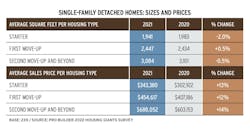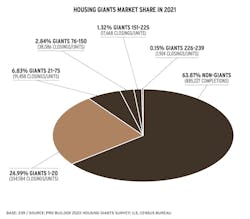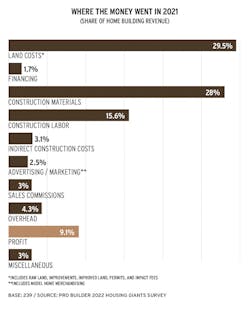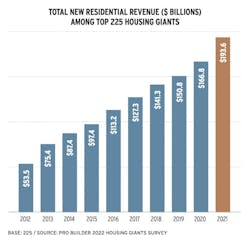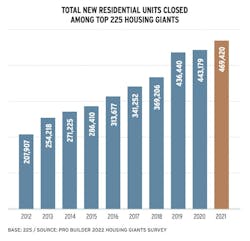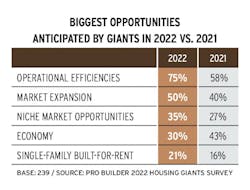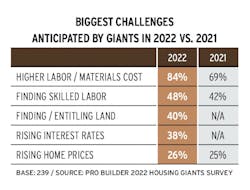What Now for Residential Construction? The Housing Industry Post-Pandemic
Assessing your home building business now versus before the pandemic is a little like getting fitted for new lenses at the eye doctor: Better ... or worse? It really depends on which lens you’re looking through. Profits? Better. Costs? Worse. Housing demand? We’ll see.
No doubt, the last two years have seen some remarkable changes in our work and home lives. But as we are already witnessing among companies that thrived during the pandemic—Zoom, Netflix, Clorox, Peloton, and a plethora of online retailers (Amazon included) currently suffering steep declines in their sales and stock values—not everything we came to know and love/hate will stick now that we’re through the worst of it.
What's in Store for Housing? Data From the Nation's Biggest Builders Provides Insights
Which means that making fundamental changes to how builders do business will be even harder than it was before COVID, and even after the residential construction industry emerged from the valley of the Great Recession. Unlike that event, this latest global catastrophe actually boosted housing’s standing as an economic engine as consumers looked for more suitable places to work and learn, be safe, and invest their stimulus checks.
But any home builder with enough experience and awareness knows that the current view of the housing industry isn’t all rainbows and unicorns. Record-setting sales prices for new homes, overall inflation across a wide swath of consumer and trade goods, and rising interest rates are already combining to soften housing demand, while new-home production remains hampered by a fickle supply chain and a chronic dearth of skilled construction labor that dates back to well before the pandemic.
RELATED: MORE 2022 HOUSING GIANTS ARTICLES AND DATA
- Housing, Industrialized: Marketing Industrialized Construction to Consumers
- Built-to-Rent: What Happens When the Dust Settles?
- 2022 Housing Giants List: U.S. Home Builder Rankings by 2021 Revenue and Closings
- 2022 Housing Giants rankings by housing type and region
Housing Industry Data From the Top 239 Home Builders Across the United States, Ranked by Revenue
Despite level or slightly smaller footages, the average sales price of a newly built home nationwide reached $453,700 at the end of 2021, a 15% increase from a year earlier, according to the U.S. Census Bureau, exacerbating the housing affordability crisis and pricing thousands of buyers out of the market.
“Significant supply-side headwinds held back new-home construction in the 2010s and resulted in a net housing deficit,” that is having an even greater impact today, says Dr. Robert Dietz, chief economist for the National Association of Home Builders (NAHB).
So, what now? Put on rose-colored glasses and ignore the signs of a slowdown or get a pair of binoculars to look out a bit farther to a new era of doing business—one that’s extremely aggressive toward wasteful spending while investing in talent and technology; a future that enables faster production of better-built homes; and a step toward innovations that fundamentally improve the game and create clear distinctions in what is likely to be a far more competitive landscape.
“Builders need to get involved in solving their problems instead of just complaining about them,” says Chuck Shinn, president of Shinn Consulting, in Littleton, Colo., who has been coaching home builders in management best practices for 50 years.
The biggest Housing Giants got bigger in 2021, growing to a full quarter of all unit closings with nearly 40,000 more homes than in 2020 and taking market share away from the next-largest tier of Giants and from non-Giants.
“We are truly at an inflection point,” adds housing sage George Casey, who champions innovation through the lens of industry realities. He’s especially bullish on off-site construction and built-to-rent and their inherent (or at least apparent) cost and production efficiencies. “But I believe it’s going to be a one or two-decade adoption period and only in high-volume markets ... and will never fully replace the current system.”
One might argue that the biggest U.S. builders—those on on our Housing Giants list, ranked by home building revenue—will lead the charge to change. Not only did they continue to increase market share (to 36% or 483,720 units; see chart, above) of all new-home closings in 2021, but they’re also more profitable, averaging 9.1% net in 2021, up from 7.8% in 2020 (see chart, below).
Land, labor, and materials continue to be the biggest costs for the top U.S. home builders, our Housing Giants data show, at the logical expense of sales and marketing investments. Despite cost increases, home builder average net profit leapt to 9.1% in 2021 from 7.8% the year before.
As such, the big builders are better equipped to weather what comes next and invest in that future with operational efficiencies and expansion into new markets and market niches, such as single-family built-to-rent and repurposing oversupplied commercial, retail, and similar spaces for residential use, among other moves.
If the first half of 2022 is any indication, the signs are there for more (not fewer) changes for a post-pandemic housing industry; ones that will surely stick better than in-home gyms and handwashing. It all depends on how you look at it.
Revenue among the giants leapt 16% in 2021, thanks in large part to escalating sales prices across all housing market segments caused by high demand and overall economic inflation.
Despite significant barriers to production, our Housing Giants data show that the residential construction industry's biggest builders still managed to close 26,241 more units in 2021 than the year before, continuing an upward trend coming out of the Great Recession that continued through the COVID-19 pandemic.
Higher material and labor costs are forcing Giants to streamline their operations and look for new markets and niches to maintain profitability, including an increasing interest in built-to-rent.
It’s more of the same as Giants anticipate weathering sustained headwinds that directly relate to housing production; a chronic skilled labor shortage has topped this list (or been a close second) every year since 2017.

